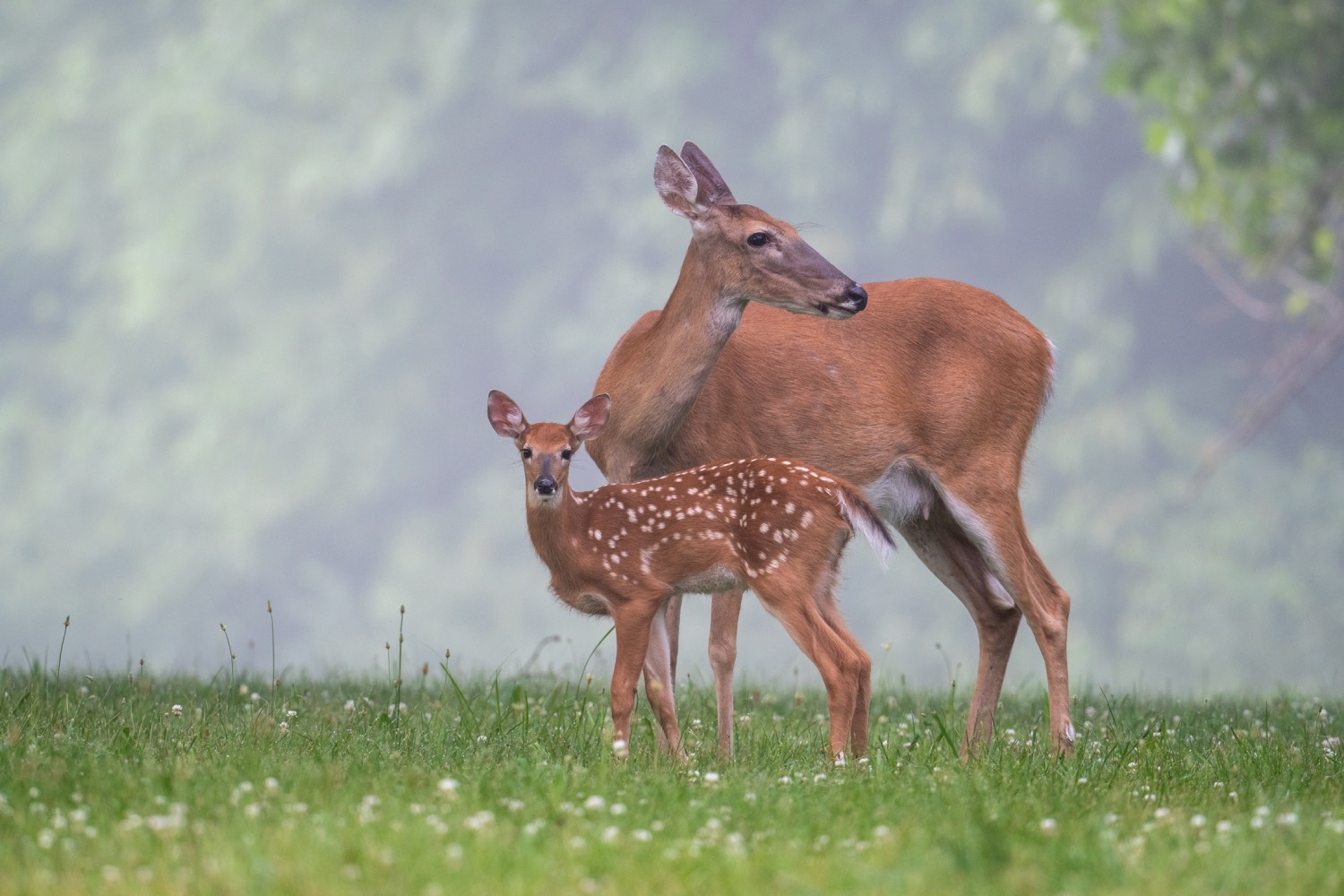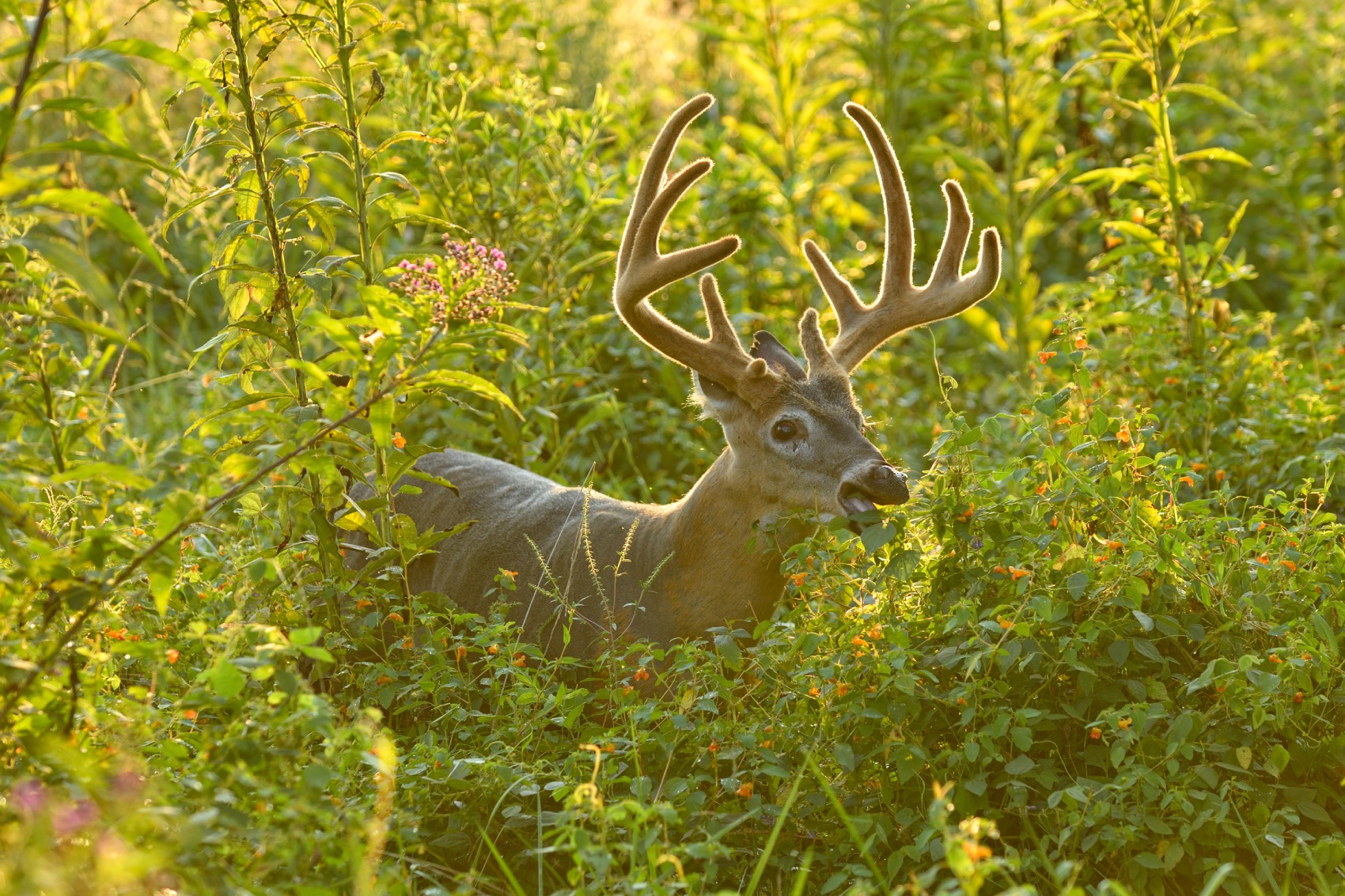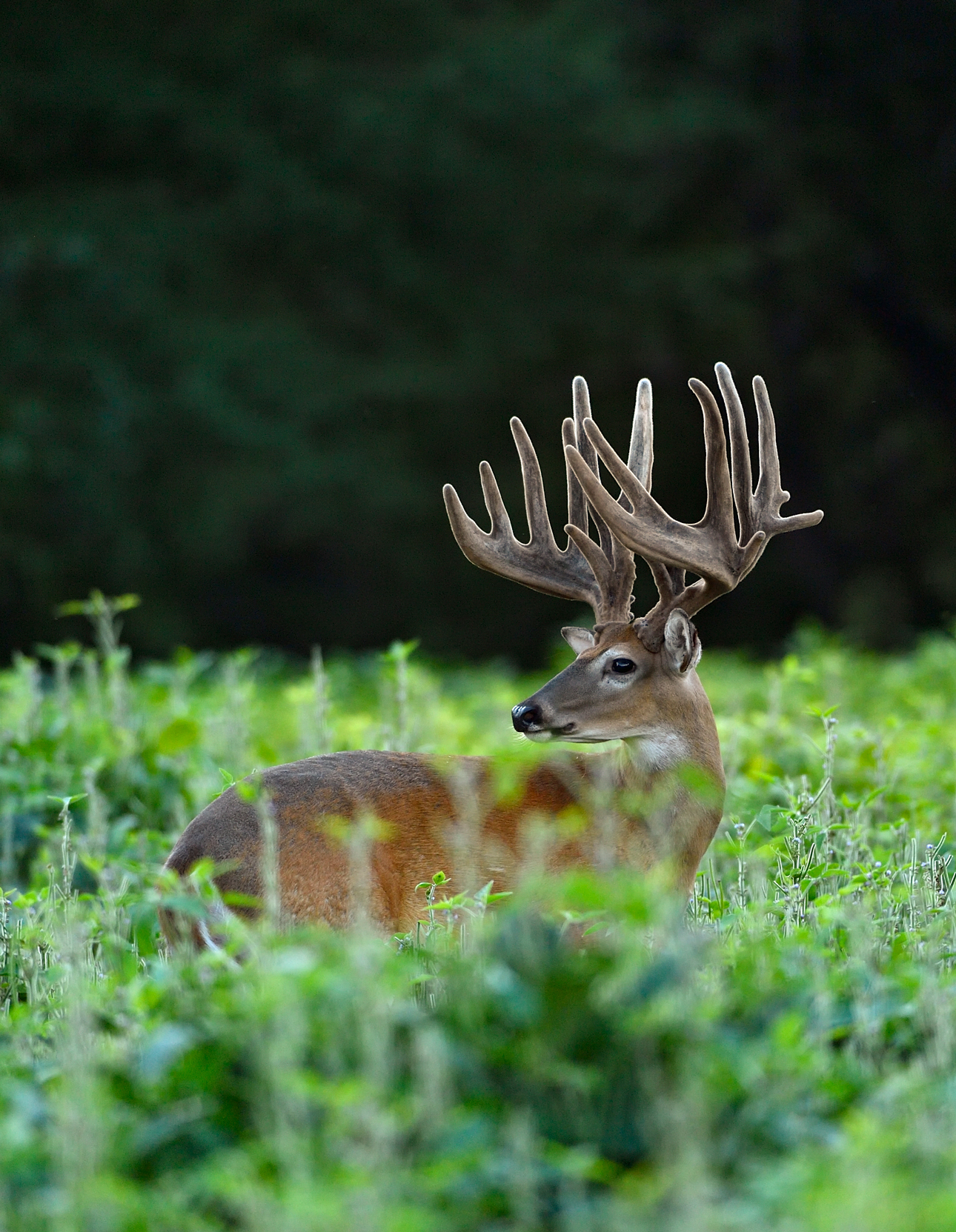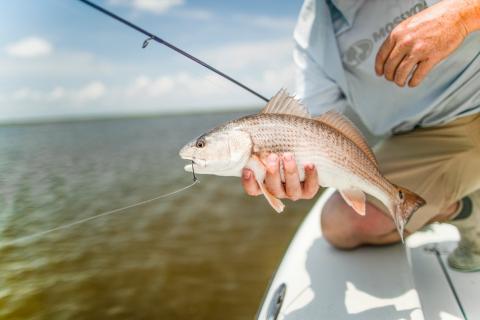Bob Humphrey
The sun has disappeared behind the western treetops, turning individual shadows into one that now covers a carpet of calf-high greenery. The air filled with the deafening hum of crickets and grasshoppers. Movement just inside the wood-line materializes into a doe, her tail spasmodically swishing insects as she stares intently into the pasture. Slowly and stiff-legged, she walks into the open, pausing to glare back into the forest. More movement reveals two tiny spotted fawns, and they rush haphazardly out of cover and toward their mother. They meet briefly, licking noses before the doe begins feeding while her offspring vie for her udders. Summer has arrived and the nursing fawns will place tremendous stress on their mother. She and they are going to need all the nutrition they can get.
Winter is an obvious period of nutritional stress for deer because food is at a period of least abundance and lowest nutritional value, but every season has its gaps and summer is the second most stressful time by a longshot. There’s usually enough food around for deer to survive. However, if you want them to thrive, you need to provide the right amount and type of food they need. This will increase the likelihood of fawn survival and improve antler size and quality.

Photography by Tony Campbell. Growing fawns need high levels of protein, which they get from nursing. This puts great nutritional stress on does.
In terms of diet, white-tailed deer are classified as “concentrate selectors.” They seek out and eat plants based on seasonal availability, relative abundance, palatability and nutrition. In other words, they know what’s good for them, what tastes the best and they seek it out. Nutrients that are most important and most often lacking are crude protein, energy and minerals. Lack of adequate nutrition can cause poor fetal development, higher fawn mortality and abandonment, poor growth and poor health, and the debilitation and death of older deer. Give them enough of what they need and the situation becomes much more optimistic.
Preferences and nutritional requirements change throughout the year so it’s important that you provide a variety of foods to meet these changing requirements. Deer need a certain level of energy to fuel body functions, but demands for this are lower during summer and food is typically abundant enough to meet their energy needs.
Summer is the time of growth for both plants and animals. Young fawns are growing incredibly fast, which requires greater relative amounts of protein for muscle mass and minerals for bone growth. They get these from their mother, which means she, too, has greater nutritional demands. Meanwhile, bucks are living the easy life, but need protein and minerals for their growing antlers.
Protein

Photography by Tes Jolly. As summer progresses, the lush, moisture-rich forage whitetails have been consuming begins to mature, dry out and lose nutritional content. It is important to have diversity, not only in your food plot crops, but also in your native vegetation.
Fortunately, food is abundant during spring, but as summer progresses many plants lose nutritional content. Assuming there’s enough of the proper soil minerals for plants to take up and transfer to deer through digestion, the greatest need during summer is protein. It’s essential for growth, weight gain, appetite and milk secretion, and hardened antlers are composed of approximately 45 percent protein. How well deer metabolize protein for body maintenance and growth, in turn, is related to nitrogen availability. That’s why the best sources of plant protein are so called nitrogen fixers, like clover, alfalfa, chicory and peas. These plants will provide the greatest protein benefit in your warm season food plots.
As most food plotters know, plants take time to grow. Annuals grow and reach peak nutrition, palatability and attractiveness more quickly, but require yearly planting. Perennials take longer but persist over several seasons. You and your deer will gain an edge if you plant both. Previously planted perennials provide protein (say that three times, fast) during spring and early summer, before spring-planted annuals have a chance to reach a more nutritious state. The latter will then begin to fill in the gaps.
Every year is different. Some years we get too much rain, others not enough. Planting “blends” rather than a “monoculture” serves as a sort of insurance policy. Clover does well in moist conditions, but its shallow root systems may not be able to access soil moisture in drier conditions. Chicory has a much deeper root system and will do better in drier conditions, or very well-drained soils. Chufa is champion when it comes to dry, sandy soils – known more for a turkey food, deer will eat the nitrogen-rich leaves and turkeys relish the tubers.
Energy
Let’s go back to energy for a moment. Deer don’t need as much now as they will in fall and winter, but they need enough to maintain body functions, power growth and ward off diseases and parasites. They get it largely through digestion of carbohydrates by microorganisms in their four-chambered stomach. The best source is cellulose or plant fiber, which you’re already providing along with protein. Still, you can’t have too much and what you plant now will be more important later on.
Minerals
Now we move to minerals, and we’ll start with the basics. Salt, most often sodium, is necessary for a range of body functions like basic metabolism and digestion. It’s usually available in sufficient supply from plants, but can sometimes be lacking in late spring due to a high turnover rate of water. If you’re concerned, you can always add a mineral block that will provide sodium, and more.
Next come calcium and phosphorous, key components in the formation of bones, especially in younger deer and bucks, for obvious reasons. Here again, they are typically available through the plants deer eat, if you plant crops like the aforementioned legumes. This is another reason why doing soil tests and following recommendations based on the results is so important. Adding a sufficient amount of the right minerals doesn’t just promote plant growth, it also ensures those minerals are available to the deer and other critters that eat those plants. Trace minerals like zinc, copper and manganese are also important for reproductive, immune and growth functions. They’re usually present in sufficient quantities but can be supplemented with mineral blocks as well.
The Essence of Life
Don’t forget water. It’s an essential component of all body tissue and a requirement for body functions. Under average conditions, deer get most or all they need from the plants they eat. However, nursing does need free water daily and it becomes more important during dry conditions when it may be lacking in plants. How you provide it depends on your particular situation, but irrigation and pond building are good options.
Transition Deficiency

Photography by Tes Jolly. There aren’t many foods that can compare to the yield of high-protein summertime forage than annual legumes like soybeans, iron & clay peas, or lablab. If the soybeans make fruit, the dried soybeans left on the stalks can be a “hunting season magnet.”
So all is well. Summer is a time of abundance when long hours of sunlight fuel rapidly growing plants, which feed rapidly growing deer; but all that is about to change. As the days grow shorter, plant growth slows, then ceases. Maturing plants shift resources to seed production and become less nutritious before they die or go dormant. Meanwhile, does are nursing their much larger, nearly weaned fawns, and antler growth is peaking. Nutritional demand is increasing while supply is decreasing, creating a potential nutrition budget deficit. All this is occurring in the shadow of yet another diet transition when they’ll need more carbohydrates to prepare for the rut and begin laying on fat for winter.
Now is when those spring plantings really start to pay off. Legumes and cereal grains like sorghum provide an abundance of both protein and carbohydrates. This is also about the time you’ll be planting cool season plots, and the sooner you can get them in, the better. Most species, like winter peas and brassicas won’t reach peak palatability and attractiveness until fall, but the rapidly growing plants will be highly nutritious, providing a buffer in the deer’s diet deficiency. Speaking of buffers, be sure you plant enough so the plots aren’t over-grazed before you get to take advantage of them – winter peas are a notorious “candy crop” and can be browsed down quickly if you do not provide enough acreage.
If you can’t plant enough because of limited resources or acreage, try to protect what you can with fencing or ribbons. You may find it more effective to protect part of the crop rather than all of it. Hungry deer are difficult to deter but if you sacrifice some, they may be less inclined to take it all.
How important your late summer food plots are also depends to some extent on how you define the seasons and where you live. Formal season changes are based on winter and summer solstice and spring and fall equinox. Many folks consider Labor Day weekend to be the unofficial end of summer, but many bird species have already begun their fall migration by then, and the first frosts could come any day in northern areas.
Those frosts bring a mixed blessing. They’ll stop growth in many plants, but that’s a good thing for brassicas. They begin converting high levels of starch to sugar. If deer were previously indifferent to the greens, they suddenly become incredibly attractive. Those sugars also offer an important source of energy and carbohydrates for deer transitioning into the next dietary phase.
The Plot Thickens
Up to this point, we’ve been largely discussing herbaceous food plots. Mast orchards are a great method for supplementing food plots and filling in nutritional gaps. Hard mast species like oak and chestnut become more important later, but some soft mast species like mulberry, elderberry, plums and paw-paw are producing mature fruit within the late summer - early fall transition period. It’s worth noting, these shrubs also offer great cover (see sidebar: The Other Element).
Conclusion
Think of year-round nutrition as a chain. We all know how that analogy works: one weak link and the potential for failure increases. Most planting efforts are directed toward attracting deer in the fall, but if you want your land to attract and hold more and healthier deer, you need to provide them proper nutrition for each and every season. Otherwise, they’ll go somewhere else to look for it and they may not come back.
Read More: Why Summer Forage is Important to Deer Population































